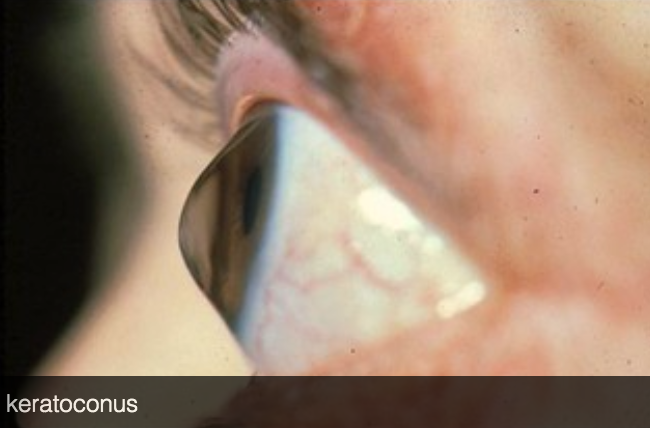What is Keratoconus ?
Keratoconus is a disease of the cornea in which the cornea , instead of being uniformly round in shape , tends to become conical , leading to progressive loss of vision.
What is the cause of Keratoconus ?
Keratoconus is caused as a result of thinning of the cornea of the eye. Normal Cornea is on an average 550 micron thick ( 1000 micron =1mm.) In patients of Keratoconus , the cornea may be as thin as 350 micron. This thin cornea , cannot withstand the pressure of fluid inside the eye and hence starts bending outwards in the form of a cone , hence the name , Kerato-Conus.
At what age does Keratoconus manifest ?
While keratoconus may start in early childhood , it may not be diagnosed until later when the child becomes aware of poor vision and then seeks checkup from an eye surgeon. Keratoconus may progress fast during the growth phase of life. Keratoconus may also be associated with severe eye allergy , where vigorous rubbing of the eyes could lead to Keratoconus.
How can Keratoconus be diagnosed ?
Advanced keratoconus may be diagnosed during routine eye examination but early keratoconus can easily be missed . The only sure method of diagnosing and monitoring keratoconus is by Corneal Pentacam Topography which gives us detailed parameters of the cornea hand helps us in making important decisions for the benefit of the patient.
Can Keratoconus be cured ?
Keratoconus cannot be cured but can be treated to achieve best possible results. Patients of keratoconus may need to consult an eye surgeon from time to time for monitoring of their problem and treatment as required.
What is the treatment of Keratoconus ?
There are two stages of treatment of Keratoconus :
1. Stabilization of Keratoconus.
2. Visual Improvement techniques.
How is Keratoconus stabilization done?
Stabilization of Keratoconus can be done with a technique called Corneal Collagen Crossliking with Riboflavin (C3R). With this technique , we first scratch the epithelium of the cornea and use a medicine called Riboflavin to enter the corneal tissue. Then the cornea is exposed to a light of a specific wavelength to activate the Riboflavin.
C3R does not improve the vision in any way. It only helps in strengthening the thin and soft cornea so that it would not continue to get deformed .
On subsequent visits after C3R treatment , Pentacam Topography is done to monitor the efficacy of the treatment.
Only once it is established to a great degree that stabilization has been achieved , that any further vision improvement techniques are advised.
How can vision be improved in Keratoconus ?
Every patient and every eye of keratoconus is different and we may need to take separate decisions in both eyes of the same patient according to the severity of the disease. We try to advise the patient with the simplest and cheapest treatments as far as possible.
Vision improvement may be done by:
1. Glasses :
If keratoconus is mild and good vision is achieved by relatively low spectacle number , glasses would be advised to the patient .
2. Contact Lenses :
Contact lenses are advised to patients where spectacle number is very high and good vision is not achieved despite using glasses. Most patients can achieve good vision with Keratoconus speciality contact lenses . If patient can tolerate these contact lenses , then he is advised to continue using them. In case patient is intolerant to contact lenses , or is unable to manage them , then he is offered other modes of treatment.
3. Intra-corneal Rings :
Intra corneal rings are specially designed devices which are implanted in the cornea in an effort to decrease the irregularity of the corneal surface. These rings may also help in reducing some number of glasses also. If after intra corneal ring implantation , vision becomes better with glasses , then the patient is encouraged to use glasses or if possible , soft contact lenses if found effective.
4. Phakic Intraocular Lens Implantation :
In case there is very high spectacle number that cannot be treated with intra-corneal rings , then we have to resort to implantation of either spherical or toric variety of Phakic Intraocular lens inside the eye.
5. Corneal Transplantation :
Corneal transplantation is the last resort in cases of keratoconus if cornea is very thin and scarred and the above mentioned modes of treatment cannot be used. A full thickness cornea grafting of a lamellar corneal grafting may achieve moderate to good results .
Can Lasik Laser help in improving vision in Keratoconus ?
Can Lasik Laser help in improving vision in Keratoconus ?
Lasik Laser is an absolute contra-indication in cases of Keratoconus and must not be done .




 Find us on google map
Find us on google map